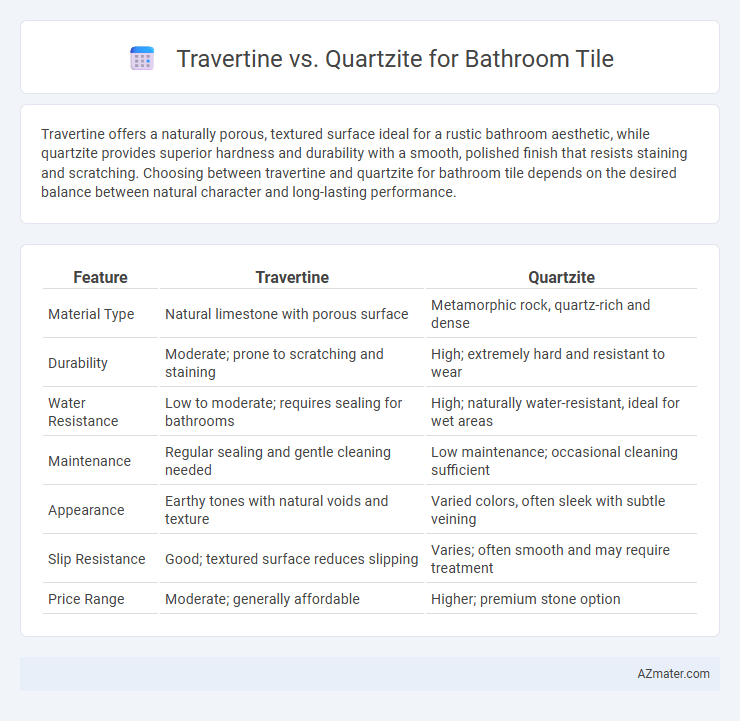Travertine offers a naturally porous, textured surface ideal for a rustic bathroom aesthetic, while quartzite provides superior hardness and durability with a smooth, polished finish that resists staining and scratching. Choosing between travertine and quartzite for bathroom tile depends on the desired balance between natural character and long-lasting performance.
Table of Comparison
| Feature | Travertine | Quartzite |
|---|---|---|
| Material Type | Natural limestone with porous surface | Metamorphic rock, quartz-rich and dense |
| Durability | Moderate; prone to scratching and staining | High; extremely hard and resistant to wear |
| Water Resistance | Low to moderate; requires sealing for bathrooms | High; naturally water-resistant, ideal for wet areas |
| Maintenance | Regular sealing and gentle cleaning needed | Low maintenance; occasional cleaning sufficient |
| Appearance | Earthy tones with natural voids and texture | Varied colors, often sleek with subtle veining |
| Slip Resistance | Good; textured surface reduces slipping | Varies; often smooth and may require treatment |
| Price Range | Moderate; generally affordable | Higher; premium stone option |
Introduction: Comparing Travertine and Quartzite for Bathrooms
Travertine and quartzite are popular natural stone choices for bathroom tiles, each offering distinct aesthetic and functional benefits. Travertine provides a warm, porous texture with classic veining, ideal for creating a rustic or Mediterranean-inspired bathroom design. Quartzite, a harder and more durable stone with a glassy finish, resists scratches and moisture, making it suitable for high-traffic, moisture-prone bathroom environments.
Overview of Travertine and Quartzite
Travertine is a natural limestone formed from mineral deposits, known for its porous texture and warm earthy tones ideal for bathrooms seeking a rustic yet elegant appearance. Quartzite, a metamorphic rock originating from pure quartz sandstone, boasts exceptional hardness and resistance to scratches and stains, making it a durable choice for high-traffic bathroom areas. While travertine requires sealing to prevent water absorption, quartzite's dense composition offers superior water resistance, contributing to its longevity in moist environments.
Aesthetic Differences: Color and Texture
Travertine bathroom tiles showcase natural earthy hues like beige, cream, and warm browns, with a distinctive porous texture that adds rustic charm and organic appeal. Quartzite tiles offer a broader color palette ranging from soft grays and whites to subtle pinks and blues, featuring a smooth, crystalline surface that provides a sleek, polished look. The choice between travertine's matte, textured finish and quartzite's glossy, refined appearance impacts the overall bathroom ambiance and design style.
Durability and Longevity in Wet Environments
Travertine, a porous natural stone, requires sealing to maintain durability and prevent water damage in bathroom settings, while quartzite offers superior hardness and natural resistance to moisture and staining. Quartzite's dense composition makes it highly resistant to wear and ideal for long-term use in wet environments, providing a low-maintenance option for bathroom tiles. Choosing quartzite over travertine enhances the longevity of bathroom flooring by minimizing susceptibility to etching, mold, and water absorption.
Maintenance and Cleaning Requirements
Travertine requires regular sealing to prevent staining and is sensitive to acidic cleaners, making its maintenance more demanding compared to quartzite. Quartzite offers superior durability and resistance to scratches and moisture, allowing for easier cleaning with mild detergents. Both stones benefit from routine sweeping and wiping to maintain their appearance, but quartzite's hardness reduces the risk of etching and damage over time.
Water and Stain Resistance
Quartzite offers superior water and stain resistance compared to travertine, making it a more durable option for bathroom tiles exposed to moisture. Travertine is porous and requires regular sealing to prevent water absorption and staining from bathroom products. Choosing quartzite reduces maintenance needs and ensures long-lasting aesthetics in wet environments.
Slip Resistance and Bathroom Safety
Travertine offers a naturally textured surface that enhances slip resistance, making it a safer option for bathroom flooring compared to quartzite, which tends to be smoother and more polished. The porous nature of travertine allows for better traction even when wet, reducing the risk of slips and falls in a humid bathroom environment. For optimal bathroom safety, travertine tiles are preferred in areas prone to moisture due to their superior grip and durability under wet conditions.
Cost Comparison: Travertine vs Quartzite
Travertine bathroom tiles typically cost between $3 to $7 per square foot, making them a more budget-friendly option compared to quartzite, which ranges from $8 to $15 per square foot due to its higher durability and natural hardness. Installation costs also vary, with quartzite requiring more specialized labor, increasing the overall expense by approximately 20-30%. Homeowners seeking a cost-effective yet elegant bathroom tile often prefer travertine for its affordability, while quartzite suits those investing in long-term resilience despite the higher initial price.
Best Uses and Design Applications
Travertine offers a warm, natural look ideal for bathroom floors and walls, especially in Mediterranean or rustic designs, thanks to its porous texture requiring sealing to prevent moisture damage. Quartzite provides superior hardness and resistance to scratches and stains, making it perfect for high-traffic bathroom areas and contemporary or modern styles where durability and low maintenance are priorities. Both stones complement various color palettes but choosing between them depends on balancing aesthetic preferences with practical performance in wet environments.
Conclusion: Which Stone is Better for Your Bathroom?
Quartzite offers superior durability and resistance to moisture, making it a better choice for high-traffic or moisture-prone bathroom areas compared to travertine, which is softer and more porous. Travertine's natural, warm textures appeal to those seeking an elegant, classic aesthetic but requires more maintenance and sealing to prevent staining and water damage. Choosing quartzite ensures longevity and minimal upkeep, while travertine suits bathrooms where style and character are prioritized over heavy use.

Infographic: Travertine vs Quartzite for Bathroom Tile
 azmater.com
azmater.com